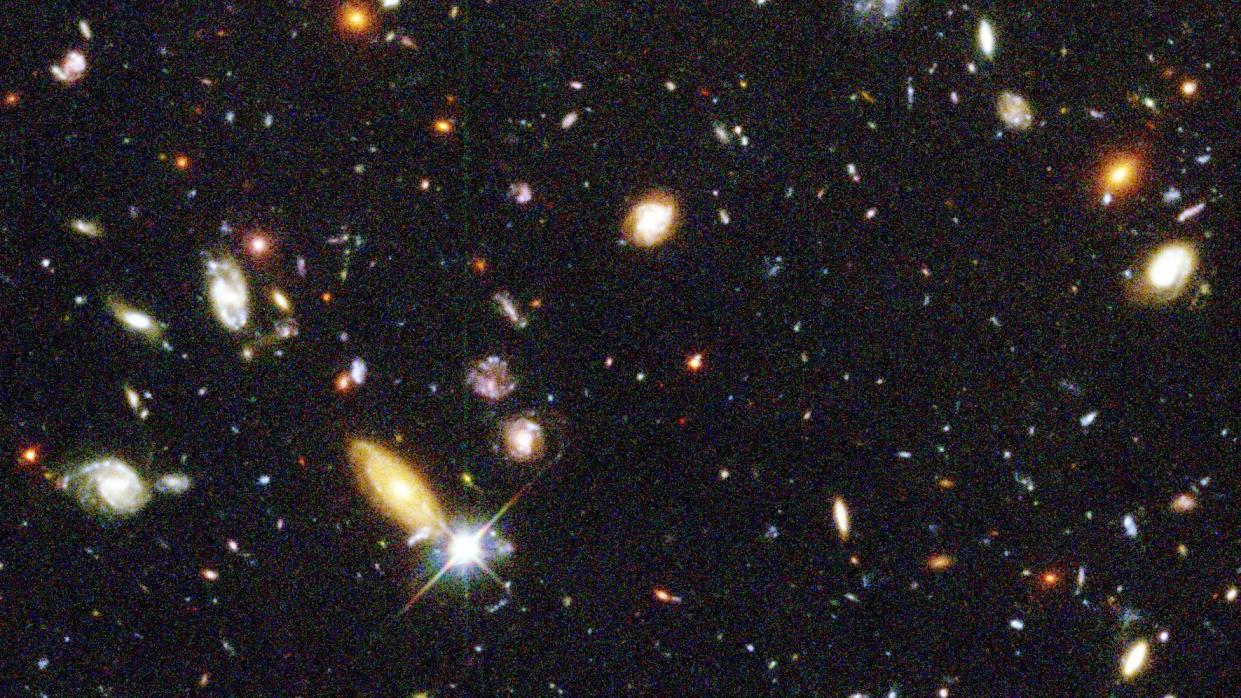The Hubble Tension Is Extremely Real—and Extremely Frustrating

Recent measurements from JWST have confirmed the validity of the “Hubble tension.”
The Hubble tension stems from the fact that measuring the Hubble constant—the rate of the universe’s expansion—two different ways will get you two different answers.
Having now pretty much ruled out that the Hubble telescope made a mistake, the question turns to what we don’t know that could be causing the discrepancy.
In the beginning, there was a bang. A … Big Bang, if you will. This massive explosion created the universe and filled it with the seeds of all the matter and energy currently present.
But with that kind of turbo-kickstart, growth isn’t something that ends after the initial blast. The universe continues to expand—even accelerating as it goes—at a rate referred to as the Hubble constant.
The Hubble constant is an incredibly important number to pin down in the field of cosmology, but it’s not an easy one to suss out. In fact, it’s so difficult to divine that the “Hubble tension” caused by our inability to land on a single number has become arguably as famous as the Hubble constant itself. And recent results from the James Webb Space Telescope (JWST) have just re-cemented this tension as a very real problem to overcome.
If a researcher wants to estimate the Hubble constant, they have two main avenues. There are others, of course, but the two most common are Cepheid variables and the cosmic microwave background.
The cosmic microwave background (CMB) is the leftover radiation still permeating the universe from the Big Bang. Using the CMB is often likened by researchers to using a baby picture to predict what someone will look like as an adult. To some extent, knowledge about the universe’s infancy should allow researchers to make predictions about its current state. Researchers have long used it to make inferences about the very beginnings of our universe, and have used it to predict what the Hubble constant should be. Fairly recent CMB calculations set the Hubble constant at around 68 km s⁻¹ Mpc⁻¹.
But the thing about theory is that you need to test it. And when the Hubble telescope launched, it became possible to do just that. Free of the constraints of ground-based telescopes clouded by atmosphere, the Hubble telescope was able to take extremely accurate distance measurements of far-off objects. And that’s where Cepheid variables come in.
Cepheid variables are a type of pulsating star that falls into a category of objects called “standard candles”—objects that have a measurable and consistent brightness, allowing us to fairly straightforwardly measure how far away they are. Measuring distances isn’t easy in space, but it’s crucial to being able to measure expansion.
As convenient as it would be to stop there, there’s one more step to the Cepheid method. Once their brightnesses have been divined, and we know how bright a Cepheid is that blinks at a certain rate, we use those brightnesses to calculate the brightnesses of nearby supernovae. Then, using a quality called “redshift,” we use those supernovae to calculate the brightnesses of other supernovae that are even farther away.
Because they’re much brighter, we can see supernovae at much greater distances than we can see Cepheids. And because you can see the expansion of the universe better the further away you look, we look to the far-off supernovae for the ultimate calculation. This chain of brightnesses is referred to as a “distance ladder,” and you can’t move to one rung without first calculating all the ones that come before.
Over time, the Hubble telescope clocked distances for several Cepheid variables (the first rung on that distance ladder), which in turn allowed researchers to make an experimental measurement of the Hubble constant. But instead of agreeing with the prediction, it came out totally different: 73 km s⁻¹ Mpc⁻¹.
When experiment and theory diverge, it can mean one of two things—either your measurement is wrong, or your theory is wrong. And that, in a nutshell is the Hubble tension. Which is wrong, the theory or the experiment?
This new round of measurements from the JWST seems to cement the idea that that there’s something wrong with the theory. Able to basically re-run Hubble’s observations with a higher resolution at wavelengths in which Hubble struggled to get clear pictures, JWST has pretty much confirmed that Hubble wasn’t seeing ghosts. It really is producing data that allow for an accurate calculation of the Hubble constant of the current universe.
So, what’s wrong with the theory, then? Well, if you can answer that, you’re light-years ahead of the best astrophysicists in the business. It could have something to do with dark energy, or dark matter, or gravity. Maybe we’re seeing all of the data fine, but we’re somehow wrong about the fundamental nature of Cepheid variables. Right now, we just don’t know.
But we’re certainly going to keep looking. Tension is just another word for puzzle in astrophysics.
You Might Also Like




